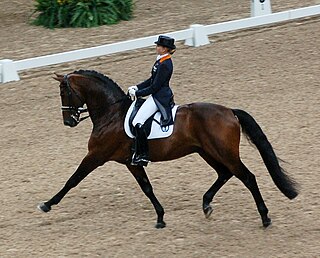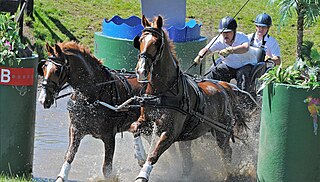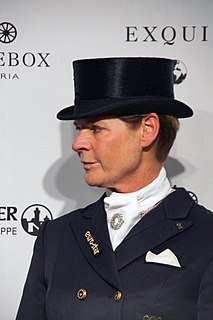
Dressage is a form of riding performed in exhibition and competition, as well as an art sometimes pursued solely for the sake of mastery. As an equestrian sport defined by the International Equestrian Federation, dressage is described as "the highest expression of horse training" where "horse and rider are expected to perform from memory a series of predetermined movements."

Eventing is an equestrian event where a single horse and rider combine and compete against other competitors across the three disciplines of dressage, cross-country, and show jumping. This event has its roots in a comprehensive cavalry test that required mastery of several types of riding. The competition may be run as a one-day event (ODE), where all three events are completed in one day or a three-day event (3DE), which is more commonly now run over four days, with dressage on the first two days, followed by cross-country the next day and then show jumping in reverse order on the final day. Eventing was previously known as Combined Training, and the name persists in many smaller organizations. The term "Combined Training" is sometimes confused with the term "Combined Test", which refers to a combination of just two of the phases, most commonly dressage and show jumping.

Equestrianism, commonly known as horse riding or horseback riding, includes the disciplines of riding, driving, or vaulting with horses. This broad description includes the use of horses for practical working purposes, transportation, recreational activities, artistic or cultural exercises, and competitive sport.

Combined driving is an equestrian sport involving carriage driving. In this discipline, the driver sits on a vehicle drawn by a single horse, a pair or a team of four. The sport has three phases: dressage, cross-country marathon and obstacle cone driving, and is most similar to the mounted equestrian sport of eventing. It is one of the ten international equestrian sport horse disciplines recognized by the Fédération Équestre Internationale (FEI); combined driving became an FEI discipline in 1970.

Equestrianism made its Summer Olympics debut at the 1900 Summer Olympics in Paris, France. It disappeared until 1912, but has appeared at every Summer Olympic Games since. The current Olympic equestrian disciplines are Dressage, Eventing, and Jumping. In each discipline, both individual and team medals are awarded. Women and men compete together on equal terms.

Fig Tree Pocket is a riverside western suburb in the City of Brisbane, Queensland, Australia. In the 2016 census, Fig Tree Pocket had a population of 4,045 people.

The All England Jumping Course at Hickstead, known widely as Hickstead, is an equestrian sport centre in West Sussex, England, principally known for its showjumping activities, where it hosts two international level competitions, the British Jumping Derby and the Longines Royal International Horse Show. The course was the first permanent showground for equestrian sport in the country, opening in 1960.
Equestrian competitions at the Beijing 2008 Summer Olympics were held from 9 August to 21 August at the Hong Kong Sports Institute and Sheung Yue River in Hong Kong. It was the second time that the equestrian events were hosted by a member of the IOC other than the member hosting the main games. Unlike 1956, however, the equestrian events were part of the main games, and were held within the same period.
The Jacksonville Equestrian Center is an equestrian facility at the Cecil Commerce Center in Jacksonville, Florida. It consists of an indoor multi-purpose arena, officially named Championship Arena, two outdoor competition arenas, two outdoor warm-up arenas, a turf arena, 426 permanent stalls, and 70 Full Service RV spaces. The facility has a grand opening in March, 2004; it is home to several horse-related events. In 2007 it was projected to be the home of the Jacksonville Pelicans of the National Indoor Football League.

Milo McIver State Park is a state park in the U.S. state of Oregon. It is in Clackamas County along the Clackamas River, near Estacada and close to Mount Hood.
Hermann Duckek was a German farmer and riding-master who built equestrian arenas throughout the World. His attention to detail and performance excellence won him the title “Duke of Dirt” - in German, “Bodenpapst”. From the foundation of the "International Dressage Trainer Club" in 1986 until his death, he was the president of this club.

Ulla Salzgeber is a German equestrian and Olympic champion who competes in the sport of dressage. Competing in the 2000 and 2004 Summer Olympics, she won two team gold medals, one individual silver and one individual bronze. She also won numerous medals at the World Equestrian Games, Dressage World Cup and European Dressage Championships. After the retirement of her Olympic horse, Rusty, after the 2004 Games, and unexpected death of her second international-level mount in 2005, Salzgeber struggled to find a new Grand Prix-level horse.

The Australian Equine and Livestock Events Centre (AELEC) is a multi building and arena complex that was designed for equine usage. It has two indoor arenas, stabling, plus an education and training building, which is located on the New England Highway approximately five kilometres south of the Tamworth Central Business District in the suburb of Hillvue.

Anne Patricia Dunham OBE is a British Para-equestrian who has competed in the Paralympic Games.

A riding hall, indoor arena, indoor school, or indoor ring is a building that is specially designed for indoor horse riding. Smaller, private buildings contain only space for riding, while larger commercial facilities contain a "ring" or "arena" within a larger building as exclusively for equestrian use, but may also incorporate additional facilities for spectators or stabling of horses.

Totilas, also known from 2006 to 2011 as Moorlands Totilas, and nicknamed "Toto", was a Dutch Warmblood stallion standing 17.1 hands high who was considered to be one of the most outstanding competitive dressage horses in the world, the first horse to score above 90 in dressage competition, and the former holder of the world record for the highest dressage score in Grand Prix Freestyle Dressage. Going into the 2010 FEI World Equestrian Games (WEG), Moorlands Totilas and his rider, Edward Gal, had amassed multiple world-record scores in international competition, leading one American journalist to call them "rock stars in the horse world". Totilas was retired from competition in August 2015 and died on 14 December 2020 due to complications from colic.

Al Shaqab is Qatar Foundation’s (QF) equestrian centre in the Al Shagub district in State of Qatar, where Arabian horses are trained. Founded in 1992 by Sheikh Hamad Bin Khalifa Al-Thani, Emir of Qatar, Al Shaqab joined QF in 2004. Al Shaqab is now the region's leading equine education resource centre and features the breeding of Arabian horses.
Para-equestrian is an equestrian sport governed by the International Federation for Equestrian Sports (FEI), and includes two competitive events: One is para-equestrian dressage, which is conducted under the same basic rules as conventional dressage, but with riders divided into different competition grades based on their functional abilities. The other is para-equestrian driving, which operates under the same basic rules as combined driving but places competitors in various grades based on their functional abilities.

The Wesley Clover Parks are recreational parklands in Ottawa, Ontario, Canada, located at the intersection of the 416 and 417 highways in the former city of Nepean. Wesley Clover Parks was established in 2014 when the Wesley Clover Foundation took over operations of the former Nepean National Equestrian Park, and the adjacent Ottawa Municipal Campground.

Susan Seipel is an Australian Para-canoeist, a gold and bronze medallist in kayak and outrigger canoe at the 2015 and 2016 World Championships. She won a bronze medal at the 2016 Rio Paralympics.
















